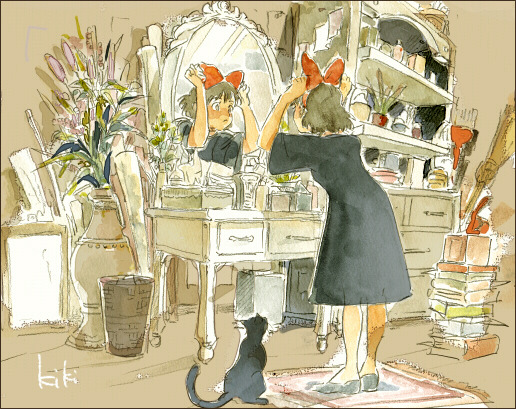Now, this year's goal was to watch all the Studio Ghibli movies and I'm sad to say I failed. I don't even think I made it half way through. In my defense I've been preoccupied with many other more pressing matters. Namely graduating college (FINALLY) and this.....

And by this I mean this actual poster and not the movie (although to be fair, I did wait in a line for approximately 20 hours at SDCC to see the Star Wars panel so it's not a far stretch to say I've also been preoccupied with the actual movie).
Let me explain....
There is a magical illustrator in the world by the name of Drew Struzan. He is the most famous illustrator that everyone knows but no one has heard of. He is the artist behind just about every movie that came out in the 80's and 90's including (but not limited to): Back to the Future I, II, and III, Indiana Jones, Hook, Harry Potter, An American Tail, Ducktails the Movie, The Great Muppet Caper, The Goonies, Hocus Pocus, Hellboy.... have I made my point yet? Oh, and he also did the posters for Star Wars I, II, III, IV, V, VI.
He was also commissioned to make a poster for episode VII. It looks like this:

Mr. Stuzan's poster was commissioned as a teaser. It wasn't intended to be the official movie theater poster. So why am I so peeved?
Because the official movie theater poster sucks.
Listen. I am officially a graduate with a BFA in illustration. I'm allowed to be pretentious about this. But I'm also inclined to explain my reasoning so let's talk about the specific issues I have with this poster
Leading Lines
The direction that lines are facing is important to the success of any composition. Line work (both actual and implied lines) usually points in the direction the artist wants the viewer to look. Instead of pointing to the action like they should, most of the lines in this poster are leading the eye off the page... the number one place that lines should never lead the eye.

I get wanting the lines to radiate from the center and in some places that works but that whole right side of the image does not work for me.
Tangents
A tangent in art terms is a space where the eye gets stuck. Instead of gliding through a composition effortlessly the viewer gets caught in an awkward artistic traffic jam and ends up fixating on parts of the image that are irrelevant. This can happen with weird line intersections, awkward overlaps, or lines that are too close to each other. If you're an artistic genius like Gary Kelley you can use tangents to your advantage and totally rock it. That is not the case with this poster. Here are some of the places where my eye gets stuck:

And I don't even think I found them all.
Low Contrast
Our eyes are naturally drawn to points of high contrast. That's why in this poster the first thing you notice is Rey. The next thing you notice are all the lightsabers. These are bight points against dark backgrounds. The issue here is in that point directly below Rey smack dab in the middle of the image where everything is smooshed together and it's hard to separate one character from the other. I mean, Han's hair meshes with Leia's hair which meshes with Chewie's hair. And it took me forever to notice that C3PO is in there along with R2D2. Poe Dameron also starts to blend in with the explosions below him as well as BB-8.

Oh, and I guess Maz is in there too...
Noise
This is just straight laziness now.
For those of you who aren't familiar with Photoshop there is a filter you can add to an image called Noise. Basically what it does is create a layer of what looks like TV static over your image. I will admit to having used it in some of my own images before but I don't like it. It looks cheap and lazy and slightly amateur. Noise also has a tendency to make things look pixelated even when they aren't. It's things like Noise that make people think that digital art is somehow easier than traditional art.
Well, this little poster is brimming with Noise.

Noise, like tangents, can be used rather expertly from time to time but this is not one of those times.
To conclude, I am whole heartedly an art snob (and I have a degree to prove it!) and I think this post above all others illustrates that point. But that doesn't negate the fact that I am right (DANG IT!)! This poster is an embarrassment to the legacy of Star Wars poster art and the moral of the story is: when given a choice, stick with Struzan.









